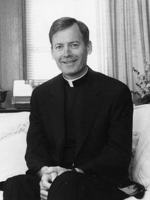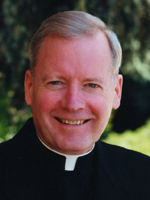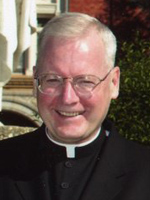 |
| In 1968, Coleman was a young priest at St. Joseph's College in Mountain View, California. |
Last year Sulpician Father Gerald Coleman ended a 16-year tenure as president-rector of St. Patrick's Seminary in Menlo Park, California, the seminary of the archdiocese of San Francisco. Here he reflects on his tenure.
In his May 6, 2005, commencement address at the University of Utah, Bishop George Niederauer of Salt Lake City revisited the history of stagecoach travel in America and its ticket classes. When the Western states were being settled, a major means of transportation was the stagecoach. There were three different levels of tickets. A first-class ticket meant that you could remain seated during the entire trip, no matter what occurred. If the stagecoach got caught in the mud, or had trouble getting up a steep hill, or a wheel fell off, you could remain seated.
If you had a second-class ticket and a problem occurred, you would have to get off until the problem was resolved. You could stand off to one side and watch other people work. You did not have to get your hands dirty.
If you had a third-class ticket, you would also have to get off, because it became your responsibility to solve the problem. You had to get out and push the stagecoach up the hill or help fix the broken wheel. Whatever was needed became the responsibility of third-class ticket holders.
When I was named president-rector of St. Patrick's Seminary and University in Menlo Park, California, in 1988, I held, or at least I thought I did, a first-class ticket. I had a doctorate in moral theology, I had taught on both college and graduate levels, I had been the president-rector of a college seminary, and I had published widely in my field. I soon learned, however, that a first-class ticket for a seminary rector and president was not the key to this position.
To be authentic and effective, it was critical to exchange the first-class ticket for a third-class ticket. It was imperative to become less a president and a rector and more of a pastor to the entire seminary community. I needed to get a third-class ticket in order to immerse myself, hands-on, in the community. A pastor by necessity holds a third-class ticket.
When I was appointed to this position, I was given three goals: diversify the seminary by introducing women to the faculty and boards, raise a somewhat low community morale, and sell a portion of the 88-acre property to build up a tottering endowment. A cascade of other concerns soon made themselves felt.
 |
| When he became president-rector of St. Patrick's Seminary, Gerald Coleman thought leadership involved a "first-class ticket." He soon learned otherwise. |
Women religious. The nuns who had ministered to the community for 89 years were leaving due to a lack of vocations. Their spiritual presence had been critical, but some people felt differently, believing that "using" women to cook and clean was outmoded and unjust. Despite this opposition, I forged ahead to find a new religious community who would teach by example the difference between servitude and service.
Diversity. The student body was becoming strongly multicultural -- eventually 51 percent of the seminarians were born outside the United States.
Physical plant. The 1989 Loma Prieta earthquake damaged the buildings and heightened the need to sell property, not only to boost the endowment, but to retrofit 99-year-old buildings.
Faculty transitions. The faculty had been stable for a good number of years -- an important element for seminary formation. This strength was weakened as some faculty moved on to other positions and tasks.
New archbishop. The archbishop of San Francisco is ex officio the president of the board of trustees, and, in the Sulpician tradition, the "first superior of the house." A change of archbishops necessarily brought new challenges.
Academic program changes. The need to strengthen the academic program brought a host of new concerns. In order to provide a wider breadth of degree programs, the seminary added to its M.Div. and M.A. programs the pontifical licentiate (S.T.L.). The addition of the S.T.L. program made significant demands on the curriculum, the faculty, and the library holdings.
New space-sharing partnership. An overwhelming sea-change happened with Fuller Theological Seminary's move to the campus. While a more complete interchange between the seminary and Fuller has not yet occurred, the presence of this prestigious nondenominational seminary on the grounds of a Catholic seminary brings ecumenical, personal, and academic possibilities to both institutions.
More space-sharing. The campus also hosted the Catholic Telemedia Network. Groundbreaking work was necessary to foster a more integral and learning relationship between this network and the seminary and Vatican II programs. The Vatican II Institute is a serious effort on the part of the Sulpicians to provide ongoing sabbatical education and formation for priests in the United States and worldwide.
 |
| Sulpician Father Gerald Coleman is enjoying a sabbatical before he returns to the faculty of St. Patrick's Seminary next year. |
Finances. Like all seminaries, St. Patrick's has faced enormous financial challenges. While the board of trustees superbly oversaw the corporate and institutional needs of the seminary, a separate board was needed whose goal would bring wisdom and wealth. The board of regents was formed, primarily to foster the seminary's fundraising and image-building. Signature points have marked their great success: outstanding leadership, community involvement, Catholic commitment, the full funding of a successful recruitment program, major oversight of the retrofitting, rebuilding and upgrading of the buildings and campus. It was at this point that I found my third-class ticket largely involved fundraising. A new challenge emerged in hiring for the first time a full-time development director.
Abuse crisis. In 2002 the Catholic church was rocked by the clergy sexual abuse crisis. This had a staggering effect on the seminary. Concerted efforts were launched to maintain the morale of faculty, seminarians, boards and supporters, and to make sure that enrollment remained steady and hopeful. This task was exhausting and at times depressing.
Where was my soul and heart in all of this? An answer might be found in my final letter to alumni and friends in the summer 2004 edition of the seminary's Patrician magazine: "Leaving St. Patrick's is a very hard departure for me. It has been my 'home' for many years, and the friends I have made will always remain part of my heart and life. Many wonderful things have happened in the past 16 years, and I feel deeply proud to have worked with an outstanding group of men and women who make up the expanse of the seminary community. I am grateful to Archbishop Levada, Archbishop Quinn and the seminary's sponsoring bishops for their many years of support and even at times correction.
"I doubtlessly have wounded some persons during this time, and for this I am profoundly repentant and ask your forgiveness. It is in my nature to want to know exactly what happens after my sabbatical, and I have been trying my best simply to put this concern aside and to rely on God's providence. I recall reading that 'we should never insert a period where God has placed a comma,' and thus I stand at this point in the sentence awaiting its completion."
 |
A brilliantly sunny day was the perfect time for a going-away celebration with some of the seminarians.
ALL PHOTOS COURTESY ST. PATRICK'S SEMINARY
|
|
I have always had a special devotion to the French Carmelite nun St. Therese of Lisieux. She wrote in her autobiography, Story of a Soul, that as with her human father, God always walked in front of her, removing dangerous stones along the path of life. I hold her as a model of holiness and good sense, asking God to always do this same clearing for me. Despite human failings and sinfulness, I feel that God has done this for me. With her as my guide, I have done my best to follow in the footsteps of Jesus as exemplified in the scriptures and the Catholic tradition.
My sabbatical ends January 1, 2006. I will live in a parish rectory, reminding me of my Sulpician roots as a diocesan priest, and I will teach moral theology at the seminary and Santa Clara University. I will also serve as the vicar for priests for the Archdiocese of San Francisco. I feel that God's writing some further words after the comma, and the sentence of my life is becoming more hopeful and fruitful. Chicago architect Daniel Burnham wrote, "Make no little plans. They have no magic to stir men's blood." Holding a third-class ticket teaches one to make and facilitate great plans.